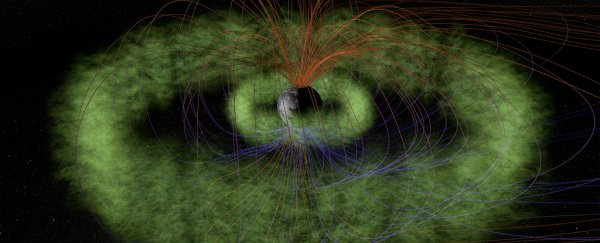Using data from two different satellites, astronomers have linked an eerie-sounding phenomenon called a whistler mode chorus to sudden bursts of electrons in the magnetosphere.
Every now and then, the drizzle of charged particles that seeps through Earth's protective magnetic shell erupts into a sudden downpour. Researchers have had their suspicions as to the cause, and now they think they've finally nailed it.
Researchers from the University of Minnesota have combined information collected by NASA's Van Allen Probes mission and the FIREBIRD II CubeSat to show microbursts of electrons hitting our atmosphere timed almost perfectly with a common plasma wave surrounding our planet.
It's a small discovery, but could have big implications, since having charged particles showering down into our atmosphere has more important effects than just pretty polar auroras.
Virtual hurricanes of charged particles ripping through space put our delicate web of satellite and surface technology at significant risk.
Knowing how we can predict and prepare for such inevitable plasma storms is high on the list of priorities for astronomers, making research like this invaluable.
Waves of charged particles – or plasma – pulse through Earth's magnetic field at various speeds and frequencies that can be detected and re-interpreted as audible sounds. Plasma waves can produce a variety of 'songs', depending on where they're located and how they're moving.
One of the stranger sounding plasma wave soundtracks is known as a whistler mode chorus, which you can experience in the track below.
While electrons constantly slip free from their electromagnetic channels to sprinkle down onto our atmosphere, we've known for some time that they can occasionally turn into a solid downpour called a microburst.
Astronomers have speculated that these electron bursts could be the source of the chorus, but until now they have never been sure.
"Observing the detailed chain of events between chorus waves and electrons requires a conjunction between two or more satellites," says lead author Aaron Breneman, a physicist from the University of Minnesota.
"There are certain things you can't learn by having only one satellite – you need simultaneous observations at different locations."
One of those locations was roughly 500 kilometres (310 miles) up, where a small satellite called FIREBIRD II collects data on electrons hitting the ionosphere.
The second was from higher up, where a pair of probes loop in a wide, elliptical orbit that takes them more than 21,000 kilometres (over 13,000 miles) from the surface as they study the rings of radiation called Van Allen belts.
Analysing the combined data, the team found chorus waves out in the Van Allen belts began chirping immediately before FIREBIRD II detected microbursts.
Again, it's one small piece of a puzzle, but with each piece that is locked in place we'll be better able to monitor and manage our response to the delicacy of our Earth's magnetic fields - and their influence on the high tech instruments we use around the globe every day.
This research was published in Geophysical Review Letters.
